Parks Canada is looking for non-invasive and inexpensive ways to monitor mountain goats – and goat poop analysis and remote cameras may just be the answer.
Wildlife experts are hoping to get a better handle on how climate change, human use and a host of other factors may be affecting goat population numbers and trends in Banff, Yoho and Kootenay national parks.
Officials say roadside and aerial surveys indicate goat numbers are down in some areas, such as the Slate Range and Bryant Creek regions of Banff, while they appear to be stable or even higher than initially thought in other areas.
But Alan Dibb, a wildlife biologist for Lake Louise, Yoho and Kootenay, cautions there are many caveats in place for obtaining robust population estimates this way, such as weather conditions.
“The picture is quite complicated because goats are widely distributed, and we don’t survey them everywhere,” he said.
“It’s extremely hard to survey goats and to get really hard numbers, but I do feel we are getting some basic information on trends in some areas.”
Dibb said while goat surveys don’t enable Parks to reliably detect small population changes, they are still useful for alerting managers to relatively large changes in populations and changes in distribution of mountain goats.
“In addition, these surveys enable us to obtain kid-adult female ratios, an important index into reproductive success,” he said.
The mountain goat is a powerful icon of northern alpine wilderness and an animal known for adapting to some of the harshest conditions and environments on the planet.
Studies elsewhere in North America are suggesting that climate change is likely to reduce mountain goat habitat and alter vegetation patterns in the animals’ mountaintop habitat.
Biologists say if the animals are already in trouble, the stress of increasing climate change could simply push many goat populations over the edge.
Parks Canada wants to develop more robust approaches to mountain goat population monitoring, particularly given helicopter surveys and radio-collaring are expensive.
Dibb said Parks is experimenting with the use of remote cameras at known mineral licks, and considering collecting goat pellets for DNA analysis as another possible option.
He said there are still challenges with such as an option, given mountain goats live in remote rugged areas and it’s not straightforward to collect pellets from throughout their range.
“With recent developments in DNA technology, we are looking at alternative ways of monitoring goats like collecting pellets, but we haven’t worked out all the details yet,” Dibb said.
“It’s still preliminary and we’re interested in exploring it further, but we’re not about to put the program on the ground just yet.”
Dibb said they are also experimenting with the use of remote cameras, noting a camera at a mineral lick near the Trans-Canada Highway in Yoho National Park has been recording mountain goats.
“Within the first few weeks of the cameras being operational, they recorded larger numbers of goats coming down to the lick than ever before and they were coming down to the highway in the middle of the night,” he said.
“Our observations during the day were relatively small, one to half a dozen animals, but we recorded a group of 19 with wildlife cameras, and we found they were coming down almost every night, which really surprised us.”
Dibb said there is a possibility of using the remote cameras in other areas, too, especially in areas where Parks Canada is aware a mineral lick is quite heavily used.
“We might not be able to use them everywhere, but we can use cameras to help determine what level of reproduction is achieved in a given year,” he said. “Obviously we can tell kid goats from adult goats.”
Dibb is also interested in any mountain goat observations from members of the public. They can be reported to him via email at [email protected].




